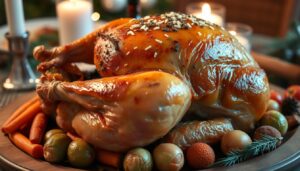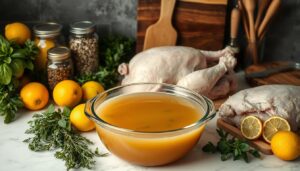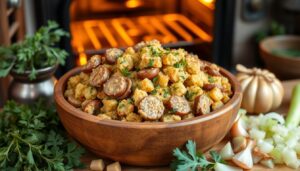Did you know Americans eat about 46 million turkeys on Thanksgiving? This shows how important turkey is to the holiday. Making a perfect roast turkey might seem hard, but don’t worry! This guide will help you make a delicious turkey that will impress everyone.
We’ll cover how much turkey you need and the best ways to cook it. You’ll learn how to thaw it right, brine it for extra flavor, and cook it to perfection. We’ll also talk about the tools you need, like a meat thermometer and a good roasting pan.
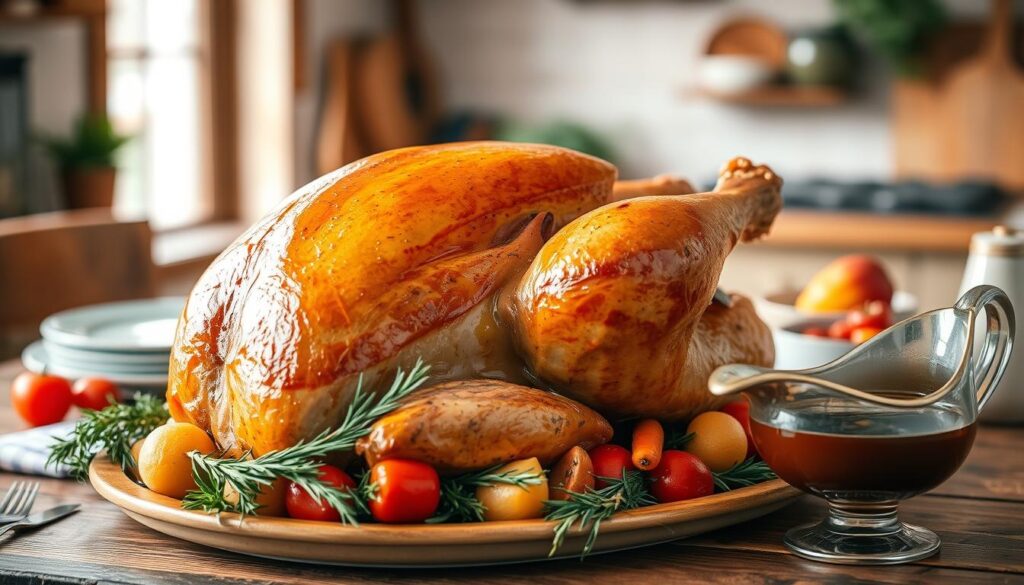
Get ready to wow your family and friends with a turkey that’s moist, tasty, and unforgettable.
Table of Contents
Key Takeaways
- Plan for about 1.5 pounds of turkey per person to ensure everyone is satisfied.
- Understand the importance of thawing your turkey: allocate 24 hours for every 5 pounds.
- Cook your turkey until it reaches an internal temperature of 165 degrees F for optimum safety.
- Rest your turkey for at least 15 minutes to allow juices to redistribute.
- Using a meat thermometer is essential for checking doneness accurately.
- Herb butter under the skin is a game-changer for flavor.
- Ensure you have the right roasting pan to avoid any last-minute issues.
Introduction to Cooking a Thanksgiving Turkey
Preparing a Thanksgiving turkey can seem daunting. It’s often the centerpiece of the celebration. Many fear cooking the perfect turkey, aiming for moistness and flavor. With some guidance, you can make a juicy roast turkey that everyone will love.
Cooking a turkey is like roasting a large chicken. The methods and techniques are similar. Follow easy steps to ensure your turkey is golden brown and tender. Remember, the turkey’s size affects cooking time and technique.
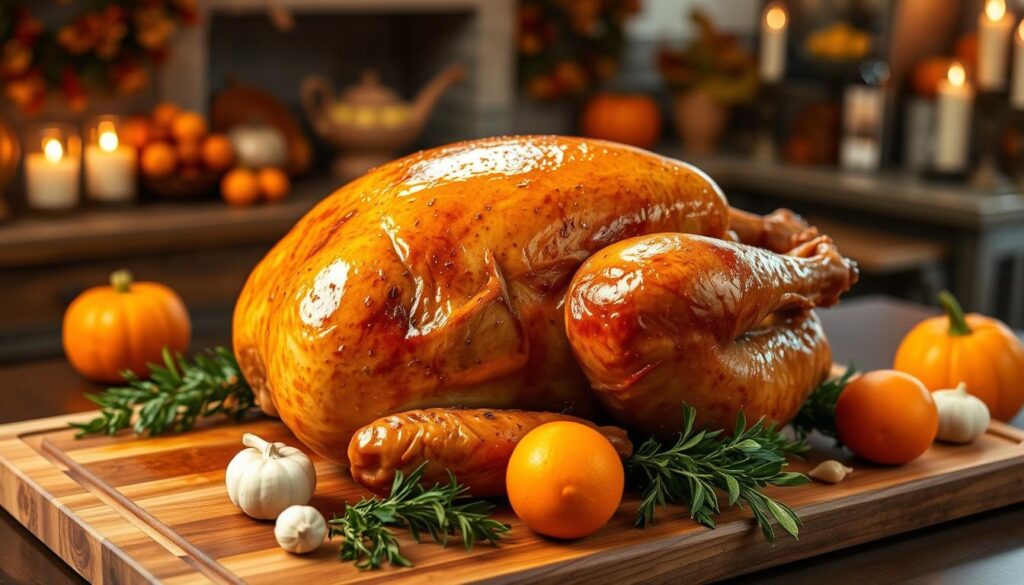
Start your turkey roasting journey by learning the necessary steps. Mastering turkey cooking means knowing how to choose the right size, thaw, and season. The following sections will help you make a stunning and flavorful main dish that will be remembered.
For a complete guide on other seasonal favorites, check out these delicious caramel apple recipes. The skills you learn will make your Thanksgiving gathering even more special, bringing joy to your table.
Choosing the Right Turkey Size
Choosing the right turkey size is key for a great feast. Here’s what you need to know to make sure your turkey is perfect. It should leave everyone happy and full.
How Much Turkey Per Person?
On average, people eat about 8 ounces of turkey. To make sure you have enough, plan for 1.5 pounds per guest. This way, everyone gets enough, especially if some guests are big eaters.
| Number of Guests | Turkey Weight (pounds) |
|---|---|
| 4 | 6 to 8 |
| 6 | 9 to 10 |
| 8 | 12 to 14 |
| 10 | 15 to 18 |
Types of Turkeys: Fresh vs. Frozen
You’ll find two main types of turkeys: fresh and frozen. Most are frozen and can last up to three months. Fresh turkeys are tasty but should be used within a few days.
Frozen turkeys need time to thaw. It takes one day for every four to five pounds. For a 12 to 15-pound turkey, thawing takes 3 to 4 days in the fridge.
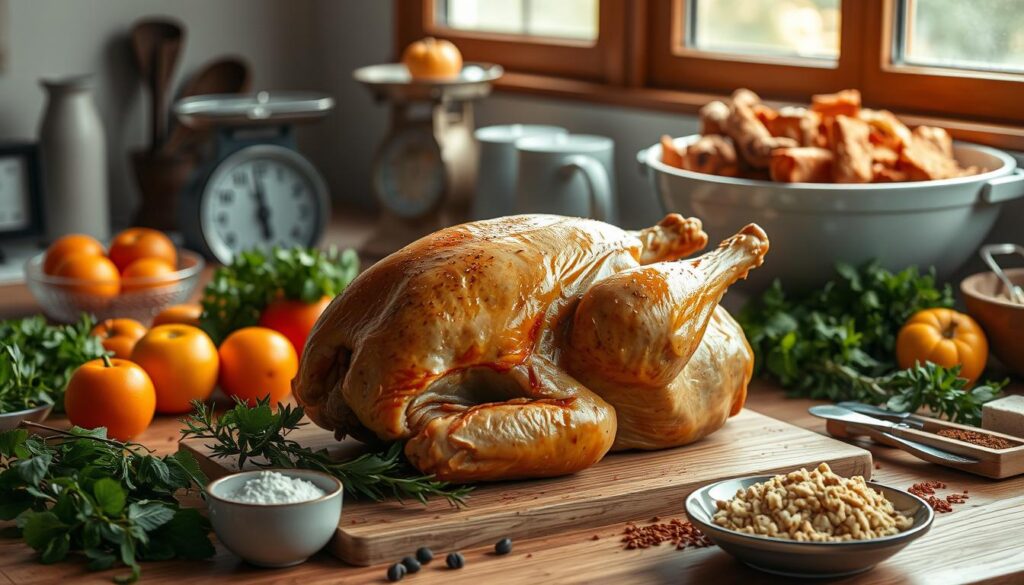
Think about choosing natural breeds for less processing. These turkeys might not taste as good as organic or heritage ones. Heritage breeds have stronger flavors but cost more. Make sure your turkey fits your cooking needs and enjoy making the perfect roast turkey this holiday.
Essential Turkey Preparation Steps
Getting your turkey ready right ensures it’s juicy and full of flavor. Follow these key steps to make your Thanksgiving turkey a hit.
Thawing Your Turkey Properly
Thawing your turkey is a must, and it needs time. For every five pounds, you need a day in the fridge. So, a 15-pound turkey takes about three days to thaw.
Don’t rinse the turkey before cooking. This can spread harmful bacteria. Instead, dry it with paper towels to get that crispy skin.
Removing the Giblets and Neck
After thawing, take out the giblets and neck from the turkey. You can use these to make a delicious homemade gravy. Simmer them with onion and herbs in water to add flavor to your gravy.
Handling these parts right makes your turkey meat even more enjoyable.
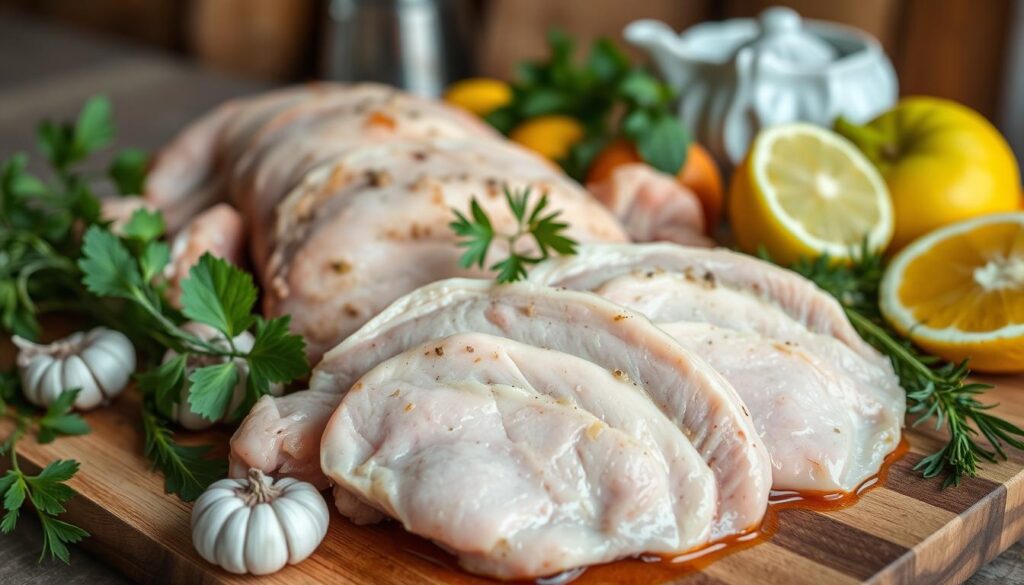
| Turkey Weight (lbs) | Thawing Time (Days) | Cooking Time at 325°F (hrs) |
|---|---|---|
| 10 | 2-3 | 2.5-3 |
| 12 | 3-4 | 3-4 |
| 14 | 3-4 | 3.5-4 |
| 16 | 4-5 | 4-5 |
| 18 | 4-6 | 4.5-6 |
| 20 | 5-7 | 5-6.67 |
Creating the Perfect Turkey Brine
Brining turns an ordinary turkey into a flavorful masterpiece. It makes sure your Thanksgiving turkey is juicy. This method involves soaking the turkey in a salty solution. This helps the meat absorb moisture and boosts its flavor.
Many think store-bought turkeys don’t need brining. But, the benefits are clear, especially for wild or lower-quality birds.
What is Brining and How It Affects Flavor
Brining means soaking meat in a salt-water solution. It changes the turkey’s protein structure, keeping it moist. This method also prevents the turkey from drying out, a common issue.
To soak up flavors well, make sure the turkey is fully covered in the brine. A mix of 3 cups of apple juice or cider, 2 gallons of cold water, 1 1/2 cups of kosher salt, and other flavorful ingredients works great. The goal is to balance flavor with moisture.
Simple Brine Recipes for Maximum Moisture
Making a simple brine at home is rewarding. A popular recipe includes:
- 3 cups of apple juice or apple cider
- 2 gallons of cold water
- 4 tablespoons of fresh rosemary leaves
- 5 cloves of minced garlic
- 1 1/2 cups of kosher salt
- 2 cups of brown sugar
- 3 tablespoons of peppercorns
- 5 whole bay leaves
- Peel of three large oranges
To make the brine, boil these ingredients together, then cool it down. Soak your turkey in this brine for 16 to 24 hours. Keep it chilled in the fridge.
Be careful not to brine for too long, as it can make the meat too salty. After soaking, rinse the turkey well to avoid too much salt.
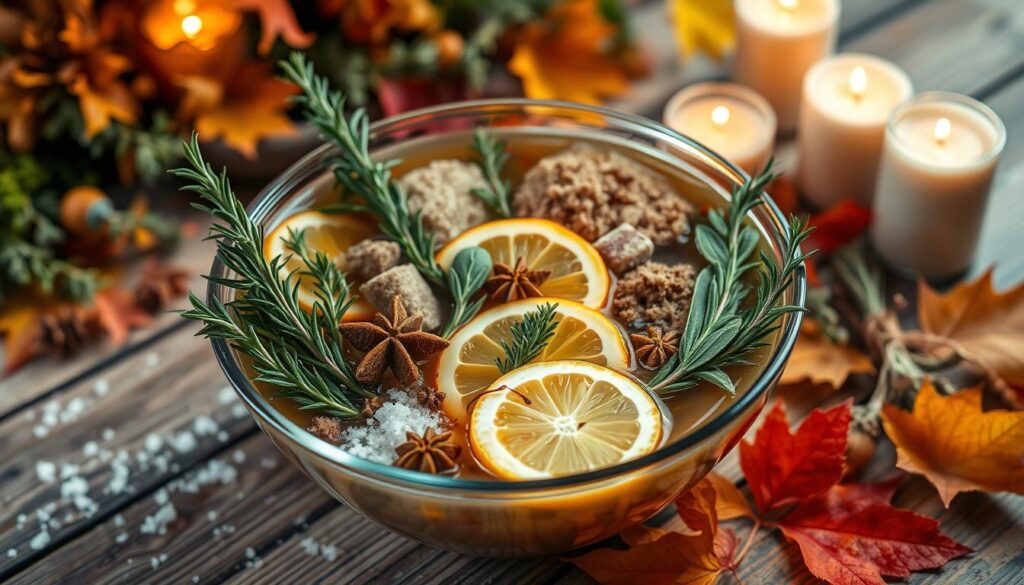
Brining isn’t just for whole turkeys; it works for parts like breasts and legs too. Choose turkeys that are not pre-brined, like organic and fresh ones. The drippings from a brined turkey can be saltier, so adjust your gravy accordingly.
If you want to make gluten-free buns for your turkey, check out this link. It has a recipe that makes your meal special and satisfying.
The Secret to a Perfect Roast Turkey
To make a moist turkey, focus on cooking techniques and temperature. Pick a turkey size that fits your party. A good rule is 1 ¼ pounds per person. A fresh turkey under 15 pounds tastes better and is easier to handle, ensuring a juicy turkey.
Preheat your oven to 450°F and roast the turkey at this high temperature for the first 20 minutes. This step makes the skin golden. Then, lower the temperature to 325°F for the rest of the cooking time. This usually takes 1 ½ to 3 ½ hours, depending on the turkey’s size. Use a meat thermometer to check the turkey’s internal temperature at the thickest part of the thigh. It should be 165°F for perfect doneness.
To add flavor and moisture, try dry-brining the turkey. Refrigerate it with kosher salt and black pepper for 12 to 24 hours. This method helps the meat absorb moisture, making it juicy. For extra flavor, rub the turkey with butter, garlic, and fresh herbs. A homemade gravy, made from the drippings and chicken stock, goes well with the turkey.
After roasting, let the turkey rest for 30 minutes before carving. This step is key as it lets the juices spread evenly in the meat. The presentation is important too; slice the crispy skin into strips and arrange them over the meat. Following these tips will help you achieve a moist turkey and a memorable meal.
| Cooking Temperature | Initial Time | Subsequent Time | Internal Temperature |
|---|---|---|---|
| 450°F | 20 minutes | 325°F for 1 ½ to 3 ½ hours | 165°F (thigh) |
Best Turkey Seasoning Techniques
Preparing a delicious roast turkey starts with the right seasoning. The right mix can turn your turkey into the main attraction. Using herb butter is a great way to add juicy flavor. It keeps the turkey moist and fills it with aromatic herbs.
Herb Butter for Juicy Flavor
Making herb butter is easy but powerful. Mix softened butter with fresh herbs like rosemary, thyme, and sage. Rub this under the turkey’s skin for flavor in every bite. Also, put some on the outside for crispy skin.
This method will make your turkey so juicy, it will wow your guests. It takes your dish to a whole new level.
Using Fresh vs. Dried Herbs
Choosing between fresh and dried herbs changes the turkey’s taste. Fresh herbs give a stronger, more vibrant flavor. Dried herbs are handy but use less, about 1/3 of fresh amounts.
Using the right herbs carefully will make your turkey taste its best. This ensures a deliciously seasoned turkey.
For more recipes and tips on flavorful turkey, check out this comprehensive guide. Your holiday feast will be unforgettable with these seasoning techniques.
Roasting Turkey Instructions
Roasting turkey needs careful attention to get a juicy and tasty bird. Follow the right steps for a great meal. Choose your roasting pan wisely, from high-end to disposable options. Add veggies like carrots, onions, and celery to the pan. They boost flavor and help cook the turkey evenly.
Preparing Your Roasting Pan
Get your roasting pan ready before putting the turkey in the oven. Make sure the pan fits the turkey well. Use a disposable pan? Place a baking sheet under it for safety. Put in your veggies and some liquid like broth or wine for moisture.
Temperature Guidelines for Perfect Cooking
Knowing the perfect cooking temperatures is key for a well-cooked turkey. Heat your oven to 325°F for roasting. Roasting times depend on the turkey’s weight. Here’s a chart to help:
| Turkey Weight | Approximate Roasting Time | Internal Temperature (Recommended) |
|---|---|---|
| 10 pounds | 2 hours 10 minutes | 165°F |
| 12 pounds | 2 hours 36 minutes | 165°F |
| 14 pounds | 3 hours 2 minutes | 165°F |
| 16 pounds | 3 hours 28 minutes | 165°F |
| 18 pounds | 3 hours 54 minutes | 165°F |
| 20 pounds | 4 hours 20 minutes | 165°F |
For the best results, check the turkey’s internal temperature. The breast should be between 155°F to 160°F. The thighs should be between 155°F to 165°F. Always let the turkey rest for at least 15 minutes after roasting. Follow these steps for a perfect turkey.
Moist Turkey Meat: Tips for Success
To get moist turkey meat, focus on a few key steps. First, let your turkey rest after roasting. This step, lasting at least 30 minutes, helps juices spread evenly. This makes each slice juicy and full of flavor.
The Importance of Resting the Turkey
Carving your turkey too early can lead to dry meat. Resting it ensures juices stay inside, making each bite tender. A rested turkey looks great and tastes even better.
Using a Meat Thermometer Correctly
Using a meat thermometer is crucial for a perfect turkey. It checks if the turkey has reached 165°F, which is key for moist meat. Stick the thermometer into the thickest part of the breast, avoiding the bone. This method prevents overcooking and keeps your turkey moist and tasty.
Try different cooking methods to improve your turkey. For more tips or to pair your turkey with gluten-free biscuits, check out this recipe.
Turkey Basting Technique Explained
Getting a beautifully roasted turkey is all about the basting technique. Traditional recipes say to baste often to get that crispy turkey skin. But, using herbed butter can make the skin crisp without constant basting.
Instead of opening the oven a lot, keep the temperature steady. This helps the turkey roast evenly and brown nicely. You won’t need to baste as much.
Start by applying a lot of butter before cooking. This butter will baste the turkey as it cooks. Baste once an hour if you want more flavor and check the turkey’s temperature.
Using tools like turkey basters or basting brushes can help. Butter gives a richer flavor than oil, making the skin tastier and crisper.
Aromatics and Fillings for Flavor
To make a turkey taste amazing, using aromatic ingredients is key. Stuffing the turkey with tasty ingredients makes every bite special. The right aromatics can make your Thanksgiving dinner unforgettable.
Choosing the Right Aromatics
Choosing the right aromatics is important for great flavor. Here are some suggestions:
- Onions: Add a base layer of savory goodness.
- Citrus Fruits: Lemons and oranges offer a bright, zesty flavor.
- Apples: Incorporate for a hint of sweetness and moisture.
- Herbs: Thyme, rosemary, sage, and parsley will enhance the turkey’s taste.
- Garlic: Cloves lightly smashed can provide robust flavor.
- Beer: Adds moisture and a unique taste, especially for smaller birds.
- Fennel and Celery: Traditional components that complement the turkey well.
- Ginger: Introduces a warm, spicy note that enhances depth of flavor.
- Leeks: Delivers a subtle onion-like taste.
- Turducken: A fun way to incorporate multiple poultry flavors.
- Spices: Employ a mix of spices for a flavorful kick both inside and out.
For a truly flavor-filled turkey, mix different aromatics. A well-stuffed bird will be beautifully seasoned. A simple trick is to mix fresh herbs and fruits in your stuffing. This ensures your turkey captures the essence of the season.
| Aromatic | Flavor Profile |
|---|---|
| Onions | Savory base |
| Citrus Fruits | Zesty brightness |
| Apples | Sweet moisture |
| Herbs | Fresh, aromatic |
| Garlic | Robust depth |
| Beer | Unique moisture |
| Fennel | Anise-like |
| Celery | Traditional |
| Spices | Flavorful complexity |
Adding these aromatics to your turkey makes a big difference. Use turkey cooking tips that focus on moisture and flavor. This ensures your holiday feast will be unforgettable.
Best Practices for Carving Your Turkey
Carving turkey is an art that makes your meal special. It’s important to let the turkey rest for at least 30 minutes. This step helps the juices spread, making the turkey juicy and full of flavor.
- Start by removing the legs: Cut through the skin where the leg meets the body. Then, bend the leg back until the joint pops and slice through to detach.
- Next, remove the thighs: Cut around the thigh joint and separate it from the body.
- Remove the turkey breasts: Make a series of slices along the breastbone, slicing down towards the rib cage. You should get two large pieces.
- Finally, take off the wings: Cut through the skin and joint to remove them.
After carving, cut each section into thick slices. A platter for a 13-pound turkey should fit eight main pieces: two breasts, two thighs, two legs, and two wings. This makes the turkey look great and makes serving easier.
Remember, each serving has about 96 calories. It also has 2 grams of carbs, 1 gram of protein, and 10 grams of fat. This info is good to know when you serve the turkey.
| Nutrient | Amount |
|---|---|
| Calories | 96 kcal |
| Carbohydrates | 2 g |
| Protein | 1 g |
| Fat | 10 g |
| Saturated Fat | 6 g |
| Cholesterol | 26 mg |
| Sodium | 168 mg |
| Potassium | 33 mg |
| Fiber | 1 g |
| Sugar | 1 g |
| Vitamin A | 332 IU |
| Vitamin C | 6 mg |
| Calcium | 11 mg |
| Iron | 1 mg |
Use a good knife, like a Japanese Honesuki, for smooth cuts. Learning these techniques will make carving fun and your turkey look amazing.
Conclusion
Cooking the perfect roast turkey for Thanksgiving is a rewarding experience. It creates lasting memories for you and your loved ones. By following the right techniques, like thawing, brining, and roasting, you can make a turkey that looks great and tastes amazing.
Make sure to brine your turkey for about 48 hours and let it dry before roasting. You can choose from fresh, brined, or free-range turkeys from places like Whole Foods. Each type can make your Thanksgiving turkey recipe even better. Always aim for an internal temperature of 165°F and let the turkey rest before carving for the best juiciness.
Enjoy cooking this Thanksgiving, knowing you’re making a perfect roast turkey. With careful planning and attention to detail, you’ll impress everyone at the table. Take your time, enjoy the flavors, and celebrate with family and friends around your holiday table.
F.A.Q
What is the best size turkey to buy for Thanksgiving?
A good rule of thumb is to plan for about 1.5 pounds of turkey per person. This ensures that everyone has enough to eat and leaves room for delicious leftovers.
Should I use a fresh or frozen turkey?
Both fresh and frozen turkeys can yield excellent results. If you choose a frozen turkey, just make sure to properly thaw it in the refrigerator for a safe and juicy outcome.
How long should I thaw my frozen turkey?
Thaw your turkey in the refrigerator, allowing one day for every five pounds of turkey to ensure safe and adequate thawing.
Do I need to wash my turkey before cooking?
No, washing the turkey can lead to cross-contamination. Instead, pat the turkey dry with paper towels to help achieve crispy skin.
What is the advantage of brining a turkey?
Brining enhances the turkey’s flavor and moisture content, leading to a juicier and more flavorful roast. It’s particularly beneficial for store-bought or wild turkeys.
How do I achieve crispy skin on my turkey?
To achieve crispy turkey skin, it’s essential to pat the bird dry before cooking and avoid basting with liquid. Using herb butter also contributes to an excellent texture and flavor.
What temperature should my turkey reach for safe consumption?
Your turkey should reach an internal temperature of 165°F in the innermost part of the thigh and wing and in the thickest part of the breast for safe consumption.
How long should I let my turkey rest after cooking?
Let your turkey rest for at least 20-30 minutes after cooking. This allows the juices to redistribute, resulting in moist turkey meat when carved.
What aromatics can I use to enhance the flavor of my turkey?
Consider using aromatics like onions, citrus fruits, apples, and fresh herbs within the cavity of the turkey. These will add moisture and flavor during roasting.
What are the best techniques for carving a turkey?
Start by removing the legs and thighs, then slice the breast meat off in even portions. Be sure to use a sharp carving knife for clean cuts and maintain the turkey’s presentation.

